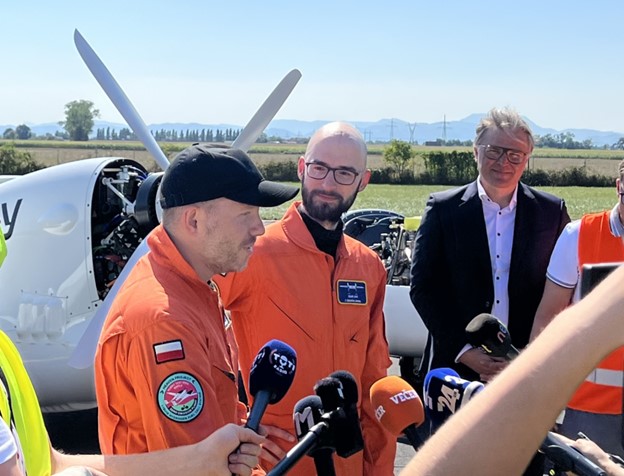 At a somewhat small and unassuming airport in Maribor, Slovenia, German hydrogen propulsion startup H2FLY has quietly been building up to a major milestone in zero-emission aviation over the summer. And all the hard work has come to fruition, with the successful completion of the world’s first crewed liquid hydrogen-powered flights.
At a somewhat small and unassuming airport in Maribor, Slovenia, German hydrogen propulsion startup H2FLY has quietly been building up to a major milestone in zero-emission aviation over the summer. And all the hard work has come to fruition, with the successful completion of the world’s first crewed liquid hydrogen-powered flights.
Before any aviation history enthusiasts out there go “but what about the Tupolev Tu-155?” — yes, the Soviets did try out liquid hydrogen as fuel 35 years ago, but only for one of the three engines. In contrast, H2FLY’s HY4 has now operated using only liquid hydrogen (as opposed to the gaseous kind) as fuel, relying solely on the hydrogen fuel-cell powertrain for the entire flight.
On Thursday, September 7, 2023, this TNW reporter was present for the fourth in a series of test flights. The event marked the culmination of Project HEAVEN, an EU-funded partnership undertaking to demonstrate the feasibility of using liquid, cryogenic hydrogen in aircraft. (That is short for High powEr density FC System for Aerial Passenger VEhicle fueled by liquid HydrogeN, just FYI.)
Liquid vs. gaseous hydrogen as aircraft fuel-While yesterday’s demonstration flight lasted somewhere around the 10-minute mark, a few days prior, the HY4 and its two pilots stayed in the air for 3 hours and 1 minute — a feat that required 10kg of hydrogen. If using up the aircraft’s full storage capacity of 24kg, it could stay up for 8 hours.
“It feels really amazing; it is the perfect teamwork coming to life,” said one of the pilots, Johannes Garbino-Anton, after the flight. He added that the technology “works perfectly,” and that the biggest difference to a normal aircraft is the lack of vibrations and noise. And, the lack of carbon dioxide emissions.
H2FLY’s propulsion system consists of hydrogen storage, a 120kW fuel-cell energy converter, and an electrical engine. All in all, this summer was H2FLY’s eighth flight test campaign. The hydrogen-electric HY4 has been flying since 2016, but this summer’s breakthrough consists of operating the plane on liquid hydrogen, as opposed to hydrogen as a gas.
Liquid hydrogen is more energy-dense than its gaseous counterpart. That means that it requires significantly lower tank weights and volume. In the world of air transport, especially when retrofitting planes, this equals not having to throw out as many passenger seats, or reduce cargo space, i.e. payload.
But perhaps more significantly, it unlocks a much greater range. For the HY4 test aircraft, this equals 750km on gaseous hydrogen vs. 1,500km on liquid — or double the distance. On the other hand, liquid hydrogen requires cryogenic temperatures (around -253°C), which adds to the complexity of transporting and refuelling.
The HY4, made out of glass fibre and carbon fibre, will not go into commercial production. The next step from H2FLY will now be to scale the fuel-cell system to megawatt capacity. The H2F-175 system will unlock not only longer range but also altitudes of up to 27,000 feet. In a partnership with Deutsche Aircraft, the two intend to retrofit a 30-seat Dornier 328 demonstrator with H2FLY hydrogen-electric fuel cells and begin test flights by 2025.
The company’s timeline is slightly more restrained than some of its competitors, but H2FLY co-founder and CEO, Dr Josef Kallo, says he foresees that an upscaled system will be capable of powering a 40-seat capacity regional plane with a range of about 2,000km by the end of the decade.
“As an engineer, I can say that a 40-seater hydrogen-powered plane is a question of money and time. After that, it becomes visionary,” Kallo stated.
However, he also added that the tests thus far indicate that it would be possible to scale up to 4MW + 4MW powertrains, which could propel larger aircraft for 80 to 100 passengers. He also does not exclude entirely new aircraft designs from new manufacturers, including, for instance, a blended wing body.
Liquid hydrogen's potential as a 'gamechanger' for commercial aviation - Something else a future of clean-burning, hydrogen-powered aviation requires is — other than the actual fuel — refuelling infrastructure. For Project HEAVEN, H2FLY has been working with Air Liquide.
For the French industrial gas supplier, which is betting heavily on green hydrogen as part of the future energy mix, it is also about demonstrating viability and shoring up industry demand. “This is the very first time we have brought liquid hydrogen to be refuelled at a commercial airport,” said Pierre Crespi, Innovation Director at Air Liquide Advanced Technologies.
The hydrogen itself arrived in Maribor by truck, following rigorous safety requirements from the Slovenian authorities.
“I cannot stress the importance of achievement in terms of the technology itself,” said Marco Rizzatto, flight test engineer at Pipistrel Vertical Solutions, who supported the integration of the cryogenic fuel tank. “Liquid hydrogen has the potential to be a gamechanger for commercial aviation.”
H2FLY was founded in 2015 by five engineers from the German Aerospace Center in Stuttgart and the University of Ulm. The company works on the propulsion system as a whole but also develops the individual components when it is necessary. In 2021, H2FLY was acquired by Joby Aviation, a California-based company developing an electrical vertical take-off and landing vehicle (eVTOL) to operate air taxi services.
Image: The mood was distinctly jubilant following the series of four successful test flights. Credit: Linnea Ahlgren/TNW
Source: thenextweb.com


